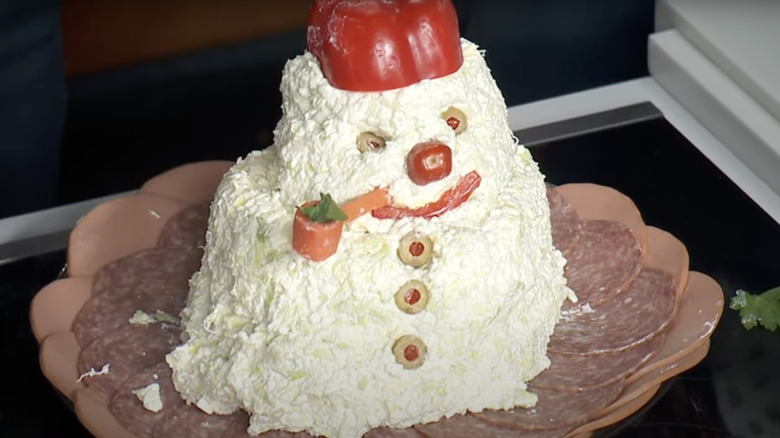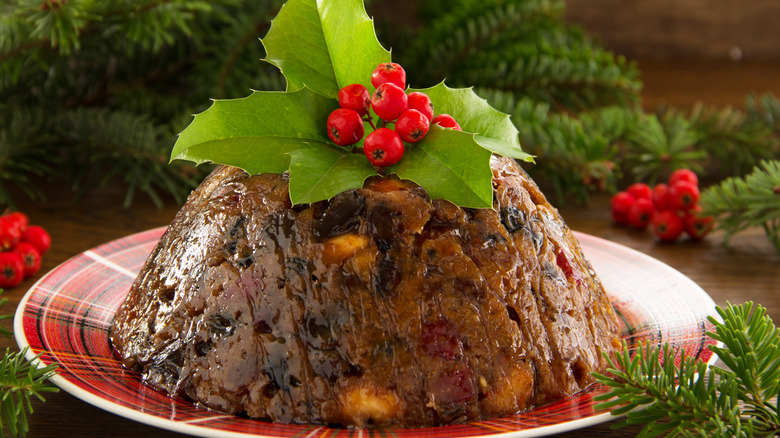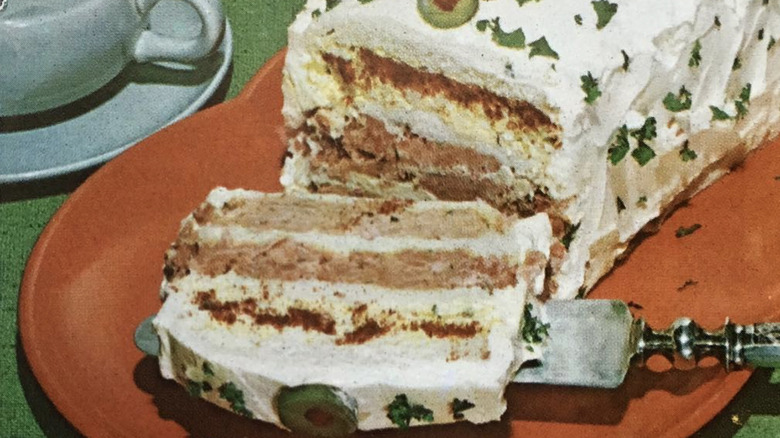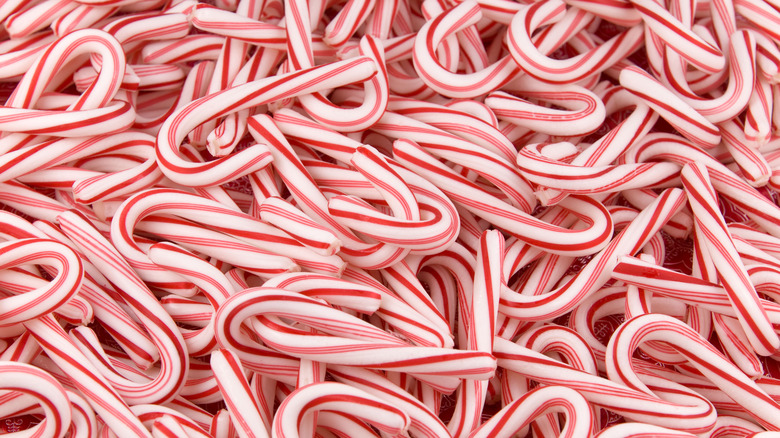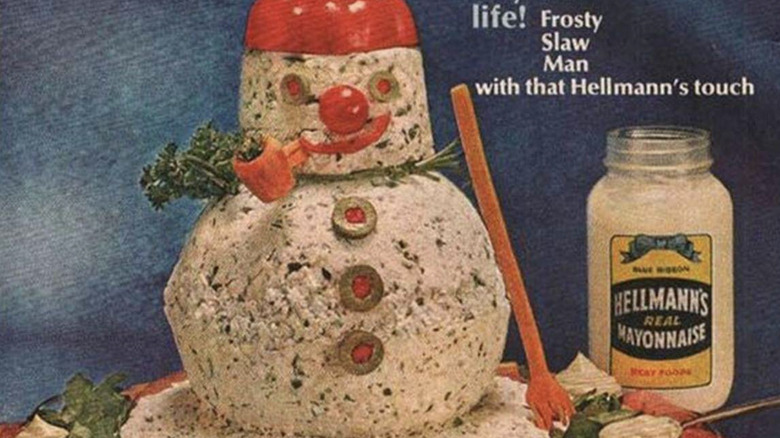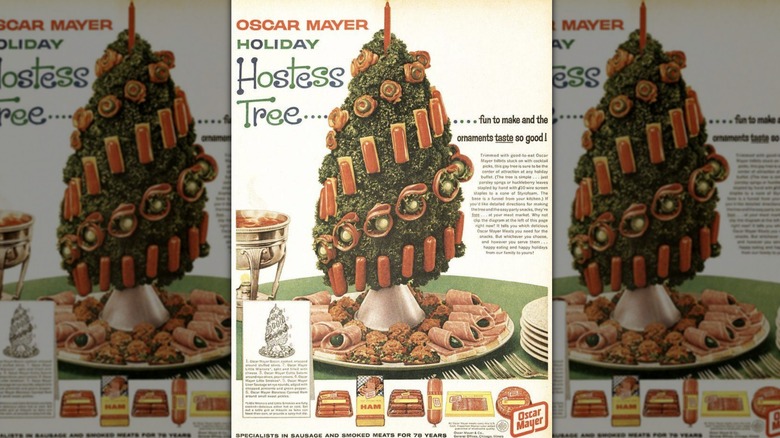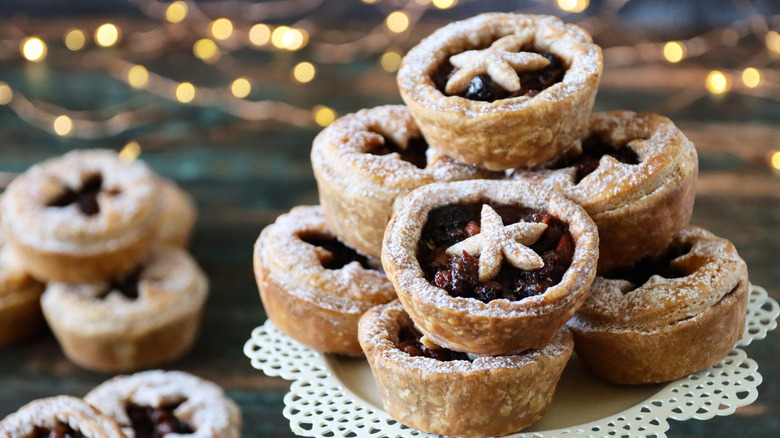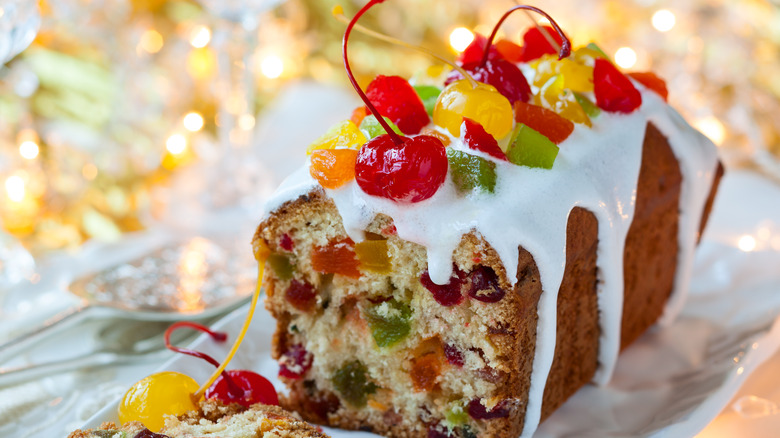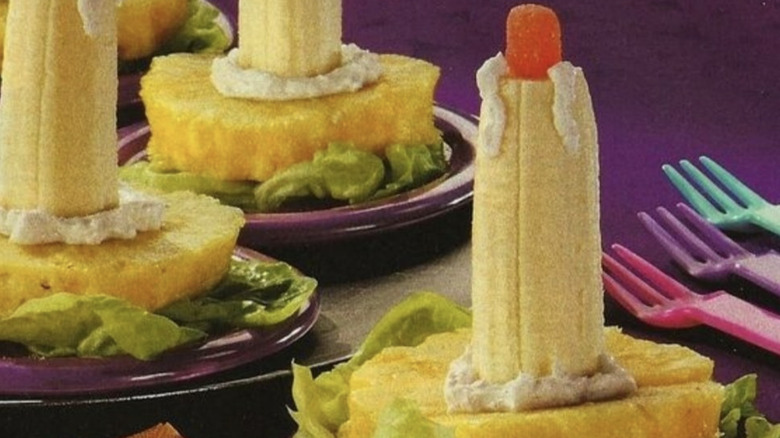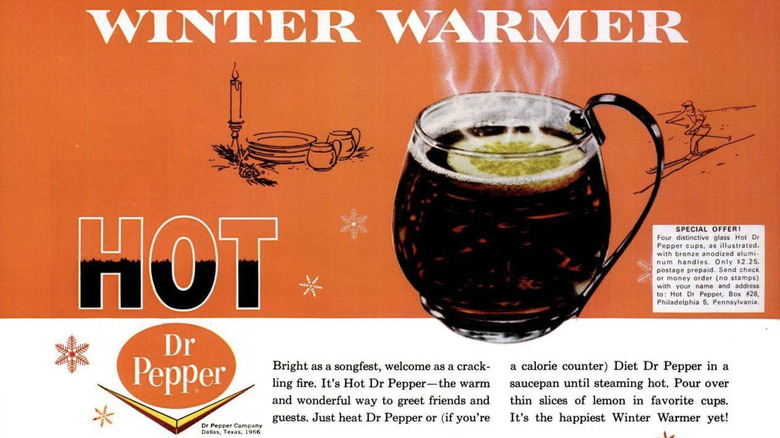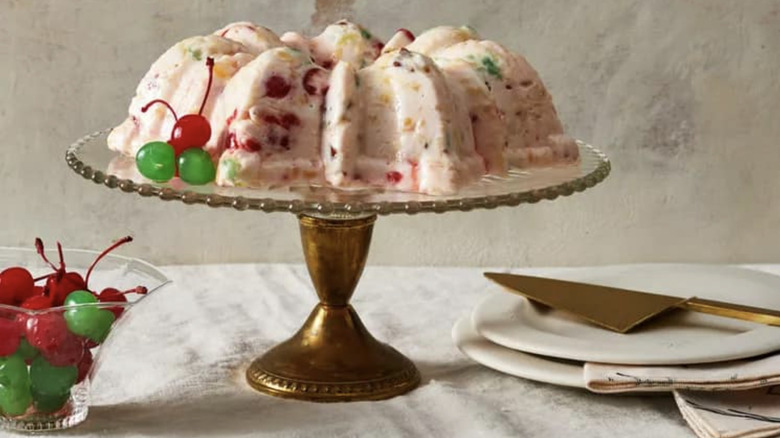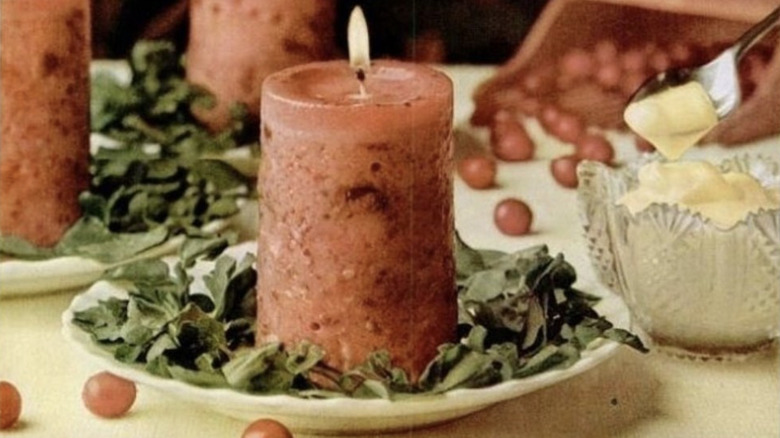The Worst Christmas Food Trends Of All Time
If you're interested in turning your next holiday party into a social experiment, consider bringing some of these Christmas classics to the table, because nothing says conversation piece like a large snowman made of cottage cheese. History has produced some seriously weird Christmas food trends and quite a few of them have managed to stick around. Holiday foods from centuries ago may come across as unappetizing because of how much tastes have changed. On the other hand, Christmas trends of 20th-century America took weirdness to a whole other level.
Despite having a bizarre taste, appearance, or both, many of these back-in-the-day food trends caught on faster than you can say TikTok. The post-war era saw women getting a little too creative with their Christmas table presentations, whereas the general kookiness of the 60s birthed Christmas foods so wacky-looking you'll risk spitting out your eggnog on sight.
Christmas is a season of novelties, and many food brands are motivated to drum up buzz around their products by advertising recipes for new holiday foods, even if that results in promoting recipes that are off-putting. Christmas is also about tradition, culinary or otherwise, which means that prunes and mutton fat suddenly pass as acceptable dessert ingredients, even though most people aren't really into that anymore. In honor of the festive season, we're putting a spotlight on the worst holiday-themed eats to haunt the holiday tables of the past and present. This is our list of the worst Christmas food trends of all time.
Figgy Pudding
Remember that line in "We Wish You a Merry Christmas" where we demand figgy pudding without knowing what it is? Well, it's inspired by true events. Back in 16th and 17th century England, it was not uncommon to encounter a gaggle of hangry carolers who demanded figgy pudding for sustenance so they could continue caroling into the night. Figgy pudding is also immortalized in Charles Dickens' "A Christmas Carol" when the Cratchit family eats a flaming, brandy-soaked version for their holiday feast which Bob Cratchit calls " ... the greatest success achieved by Mrs. Cratchit since their marriage." That's a lot of hype for a mound of steamed cake heavy with dried fruit, spices, breadcrumbs, and animal fat — though soaking it in booze and lighting it on fire is a welcome addition.
There's so much festive history behind figgy pudding and yet — it's pretty gross. It must be said that "pudding" in England is not the smooth custard we're accustomed to in the U.S. Instead, pudding refers to a sweet treat Brits enjoy after a meal ... not that early recipes for figgy pudding were exactly sweet. In medieval times, the fruit, spices, grains, and meat used to make figgy pudding were stored inside a casing of cow or sheep stomach to stay fresh. Now that we have refrigerators, bakers can skip that step, but raisins and animal fat like tallow or suet are still part of the deal — so is the brandy, but we're not biting.
Very Merry Party Loaf
That red and white-frosted cake looks amiss next to the appetizers until you realize the icing is mayo and cream cheese, and the cake is sandwich bread layered with egg, tuna, and ham salads. You've just encountered Very Merry Party Loaf, and it was once a Christmas food trend. Very Merry Party Loaf is a collaborative recipe from mega-brands Kraft and Hormel. The food it's based on — sandwich loaf cake — was popular in the 1950s, and it's more complicated than your average party sub.
After World War II, a booming economy and expanding suburbs made at-home entertaining all the rage. These gatherings typically involved a spread of colorful, heavily garnished foods, and sandwich loaf cake fit right in. The triple-decker cake was based on a Scandinavian mid-century favorite called smörgåstårtan, a multi-tiered, shareable sandwich featuring different types of fish, meat, veggies, or herbs, and "frosted" with cream cheese. When Kraft and Hormel created Very Merry Party Loaf, the intriguing ingredients you might find in sandwich loaf cake were swapped for canned meat and mayonnaise.
Slicing into a Very Merry Party Loaf striped with three mayo-based salads is one thing, but its laundry list of unharmonious supporting ingredients like relish, peanuts, and crushed pineapple is overkill. We could get down with cream cheese-smothered bread, but Very Merry Party Loaf's recipe instructs you to mix the cream cheese with mayo. Don't forget to put some aside, dye it red, and pipe it along the edges.
Candy Canes
This might seem cutthroat, but when was the last time you actually ate a whole candy cane? We cannot picture Christmas without the onslaught of candy canes, however, their sheer abundance during the holiday season has made them feel more like an obligatory prop rather than a candy we crave. The origin of candy canes has been traced back to western Germany when in 1670, a choirmaster at the Cologne Cathedral passed out sugar sticks to occupy restless choirboys during a live nativity ceremony known as creche. Whether the choirmaster bent the candy sticks into hooks to look like shepherd's staffs is up for some debate. Some historians maintain that candy manufacturers added the hook so that candy canes could be hung on Christmas trees.
Candy canes rank low on the list of Americans' favorite Christmas candy, and yet there always seems to be one just an arm's reach away. Why? Because an estimated 1.76 billion candy canes are produced every year — and that's just in the U.S. Seeing as candy canes are sticky, take forever to eat, have an awkward shape, and absorb the taste of their plastic sheath when they get stale (which is often), their appeal hardly stretches beyond decorative purposes — until you smash them. That's right, candy cane redemption only occurs when they are hammered to bits and sprinkled into a chocolatey dessert like peppermint bark. A festive tin of peppermint bark will never make this list because it is a true Christmas blessing.
Frosty Slaw Man
American deli turned mayonnaise empire Hellmann's once paid homage to one of Christmas' most timeless characters, Frosty the Snowman, and the results have gone down in curdled cheese infamy. Frosty Slaw Man and his beady, red pimento olive eyes sat precariously on holiday tabletops back in the 1960s. He wore a red bell pepper hat and smirked at guests with his mischievous red pepper smile while smoking parsley out of a carrot pipe — like a boss. Hellmann's ad was peculiar, with lines like, "Welcome new man in your life!" and "He's got a heart of Hellmann's" imploring us to romanticize this mythical snow creature made of cabbage and cottage cheese and then ... eat him.
We imagine partygoers dexterously scooping away at Frosty Slaw Man until he ceases to be nothing, and the feeling that accompanied it is akin to breaking off a chocolate bunny's head and crushing it with your teeth. Then there was the risk of hacking into Frosty's lower half disproportionately, causing his mayonnaise and gelatin-bonded form to slap — er, melt, into the tabletop with dramatic force. This retro Christmas trend has gotten pickup in recent years, with vloggers and news anchors attempting to fashion Frosty Slaw Man on camera. Traditionally, Frosty Slaw Man is positioned around a bed of deli meat, but a recipe this eccentric begs for improvisation. If your friends aren't keen on cottage cheese sculptures, why not build Frosty Slaw Man out of tuna fish salad? Hellman's would probably approve.
Holiday Hostess Tree
We've all been to gatherings where the platter of cocktail weenies quickly disappears, so why not supply the meat in grandiose fashion with a Holiday Hostess Tree? At least that's what Oscar Mayer suggested circa 1961. The tree begins as a 10-inch Styrofoam cone impaled by a kitchen funnel for the base and the "needles" are a lush bed of parsley springs stapled to the cone. The original Holiday Hostess Tree calls for "ornaments" fashioned from bacon-wrapped stuffed olives, salami wrapped around a mini-skewer of olive and pearl onion, cocktail wieners split and sandwiched with sliced cheese, and plain cocktail wieners (preferably Oscar Mayer Little Smokies). The ornaments are fastened to the tree with toothpicks and ready for the taking.
Got all that? Good, because there's more. Every respectable Christmas tree has presents underneath, so Oscar Mayer has that covered, too. Gherkins swaddled in canned ham are simple and mildly nauseating offerings, while liver sausage encircled by a wreath of pimento and green peppers atop pumpernickel rounds make for more elaborate gifts of trepidation. Few food brands scream Americana like Oscar Mayer, and few trees scream "gobble me up" like this one, but the Holiday Hostess Tree is better suited to a holiday episode of "Mad Men" than at a Christmas party in the 21st century. With meat and condiment pairings that don't appeal to millennial palettes and an unabashedly gimmicky presentation, the Holiday Hostess Tree is a silly-looking vehicle for the food we no longer want.
Mince Pie
Most Americans wouldn't bat an eyelash if mince pie was outlawed (which it was in the 17th century), but these petite pies with sticky dark insides are a hardcore Christmas tradition in the U.K. We aren't saying these little guys aren't adorable — they are — we're saying they don't taste that good. Mince pie's contents and origin story bear similarities to that of its eccentric cousin Figgy Pudding. Both are British, very old, and contain a combination of ingredients we'd prefer to pass up.
For starters, the name mince pie references the bits of minced meat that were originally part of the recipe, along with spices, apples, dried fruits, and a dousing of brandy or red wine. By the 19th century, meat was largely omitted from mince pie, although beef suet or lard is still a typical ingredient. Mince pies often feature a stylish, open-work crust in the shape of a star or other festive design. Back in the day, however, you were more likely to see a mince pie crust shaped like baby Jesus. Puritans didn't take kindly to the sacrilege of eating dough shaped like their Lord and Savior, and this led to mince pies being illegal during the 1600s. The ban didn't last, although, it may have played a part in why the mince pie Christmas trend never really took off stateside. It's still possible to buy mince pies in the U.S. — if you know where to find one of the few bakeries that sell them.
Fruitcake
Somewhere along the line, fruitcake became a scorned holiday confection, and the sentiment turned out to have quite a ripple effect. It didn't help that influential figures like talk show legend Johnny Carson declared fruitcake as "the worst Christmas gift" which became a running joke on "The Tonight Show." The festive colors of the fruit and nuts are kind of pretty, and a homemade version might be able to hold its own beside the chocolate bundt cake and cookie tray if not for the preexisting reputation of being the most generic Christmas dessert of all time.
Why did hating fruitcake become a trend? To begin with, fruitcakes are heavy. The dense, bread base of the cake faces a buoyancy challenge right out of the gate. Once you load it up with candied maraschino cherries and pineapples, dates, nuts, and whatever else might be camouflaged inside, the cumbersome loaf becomes worthy of all those ruthless doorstop comparisons. Fruitcake as we know it has been around since the Middle Ages and has been known to last unspoiled for upwards of 100 years thanks to its preserved ingredients and a long soak in bourbon. We agree that a slice of dry, kind-of-tastes-like-nothing supermarket fruitcake deserves a firm "no thank you", just as we believe that a good fruitcake recipe can launch this long-shunned Christmas classic into culinary betterment. Soaking the dried fruit in rum or black tea overnight and easing up on the radioactive-colored candied elements give fruitcake the refinement it deserves.
Christmas Candle Salad
The precise beginnings of the Christmas Candle Salad are hard to pinpoint, but one look at this festive salad might have you thinking that a group of housewives wanted to play a trick on the world. Some say Christmas Candle Salad came about as early as 1916 as part of a socialite menu. This seems like a one-and-done write-off, but the recipe held traction from the 1920s to the 1960s due to showcasing bananas and pineapples which were popular in the United States at that time. Christmas Candle Salad is a simple yet phallic twist on conventional fruit salad. To make it, a nearly whole banana is dressed on a bed of lettuce or holiday napkins, and garnished with cream and a customizable finishing touch — a maraschino cherry, gumdrop, or slivered almond were popular stand-ins.
When it comes to Christmas Candle Salad, the takeaway is that you can't make this stuff up. Structurally speaking, this "fruit" salad was problematic from the start, although it's the ingredients that propel this bygone Christmas food trend into dubious territory. When the recipe popped up in a 1957 edition of Betty Crocker's "Cook Book for Boys and Girls," it was described as " ... better than a real candle because you can eat it." From a taste standpoint, it sends shudders down our spines for all the wrong reasons. The "candle wax" slathered on the banana's sides is traditionally made from mayonnaise, cottage cheese, or whipped cream. Thanks, but no thanks.
Hot Dr Pepper
Sipping warm beverages by the fire is a well-worn holiday tradition, one that Dr Pepper aimed to challenge decades ago. Hot Dr Pepper was a Christmas trend through and through, and despite catching on in some circles, it just doesn't feel natural. Not that Dr Pepper made a name for itself by being sourced from the earth or anything. The American soda brand has been in existence since 1885, but circa the 1960s, the company got creative in order to keep sales up during the cold weather months. Supposedly, heating up Dr Pepper in a saucepan and drinking it with a slice of lemon mellows out the carbonation and makes it taste similar to spiced black tea. Some taste testers have described hot Dr Pepper's flavor profile as being closer to a melted Tootsie Roll — though it's hardly the first time a brand's marketing efforts were a little off.
That said, the ads for hot Dr Pepper that ran in the mid-1960s are nice to look at. The catchy tagline "Winter Warmer" makes us feel cozy inside and the jovial cartoon snowman getting down with some hot Dr Pepper has us yearning for simpler times. Ultimately, though, we aren't convinced. It's a beverage that represents retro Christmas at its kitschiest, but lacks a broader appeal. We have a hard time believing that many people would choose a mug of hot soda that kind of tastes like sweet black tea when they can just ... drink black tea.
Christmas Snow Salad
Unflavored gelatin sounds too lackluster to be the main component in Christmas Snow Salad, but it gets a wild flavor upgrade thanks to supporting ingredients like boiled pineapple juice, mayonnaise, and powdered whipped topping mix. Christmas Snow Salad came to the party as one of Southern Living's original recipes in 1982, and to this day, the magazine promotes it during the holidays, describing it as one of their most cherished congealed salad recipes.
We don't mean to sound picky, but putting the words congealed and salad together doesn't make us want to rush to the table. We can't help but wonder what it is about sending miscellaneous foodstuffs into the zero-gravity oblivion of a Jell-O encasement, and yet here we are. Savory Jell-O salads were common fare at many formal gatherings in mid-century America, and even now, gelatinous recipes like Christmas Snow Salad endure. Making Christmas Snow Salad involves embracing the amalgamation of not just gelatin, fruit juice, and mayo, but also an insistence on folding in accouterments like red and green maraschino cherries, and nuts (walnuts or pecans).
Everything about this opaque Jell-O mold screams old-fashioned, but the folks at Queens-based Evil Twin Brewery used this mumsy trend as inspiration for a festive beer. Its Christmas Snow Salad beer is a sweet, purple-ish-hued ale that combines the sweet and sour notes of the dish with the richness of sugary milk, daring to set forth a new Christmas foodie trend of the hipster kind.
Cranberry Candles
Don't splurge on tabletop Christmas decor you might never use again when you could light up some candles ensconced in gelatin, cranberry sauce, and mayonnaise instead. According to the Hellman's brand, it's not a real holiday party until people are chomping on the centerpieces. Suspicious? Back in the 1960s, someone at the Hellman's corporate office thought advertising a Christmastime recipe for Cranberry Candles was a bright idea.
Mid-century America was a mayonnaise-happy era, and Hellmann's was hell-bent on being a part of the Christmas dinner celebration. For those who thought canned cranberry sauce was relegated to Thanksgiving should think again. The recipe for Cranberry Candles perpetuates every yesteryear Christmas food trend that we've come to criticize, by not only using store-bought ingredients in laughingly obvious ways, but by also trying to pass off said holiday dish as a multi-functional piece of the festive table.
The recipe for Cranberry Candles centers on a jellied cylinder of canned cranberry sauce but urges recipe followers to lambast the stuff with the likes of mayo and gelatin, before punctuating the mass with walnuts, apples, or oranges. The finishing touch is, of course, the cramming of a candle inside, a candle that will be lit in the name of Christmas. We lament to say that a fully formed version of Cranberry Candles includes the telltale ridges of the cranberry sauce can, and the recipe's insistence that the jellied mass be lit ablaze forces us to reconsider the appropriateness of an edible candle holder.
